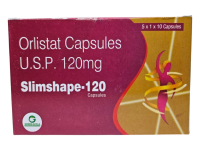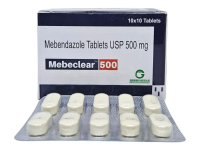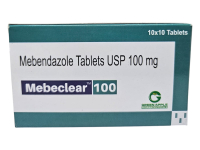Rolimus 10mg (Everolimus)
Rolimus 10mg tablets are mainly indicated for the treatment of Renal carcinoma.
Rolimus 10mg tablets are mainly indicated for the treatment of Breast carcinoma.
Rolimus 10mg tablets are mainly indicated for the treatment of Brain carcinoma.
Rolimus 10mg is also used in various advanced stage cancer in stomach, intestines or pancreas.
DESCRIPTION
Rolimus 10mg is a derivative of Rapamycin (sirolimus) and works similarly to Rapamycin as an mTOR (mammalian target of rapamycin) inhibitor.
It is normally used as an immunosuppressant to prevent rejection of organ transplants.
In a similar fashion to other mTOR inhibitors Everolimus' effect is solely on the mTORC1 protein and not on the mTORC2 protein.
INDICATION
Rolimus 10mg tablets are mainly indicated for the treatment of Renal carcinoma.
Rolimus 10mg tablets are mainly indicated for the treatment of Breast carcinoma.
Rolimus 10mg tablets are mainly indicated for the treatment of Brain carcinoma.
Rolimus 10mg is also used in various advanced stage cancer in stomach, intestines or pancreas.
MECHANISM OF ACTION
Everolimus is an mTOR prohibitor, joints at high compatibility to FK506 binding protein 12, via producing drug complex whichinhibits the specific of mTOR.
This inhibition decreases the activity of effectors downstream, that may cause blockage of cell progression from G1 into S phase, subsequently causes cell growth arrest and apoptosis
PHARMACOKINETICS
ABSORPTION
The high plasma concentration time of Everolimus is 1 to 2 hours.
The effect of food with Rolimus 10mg that with heavy meal: Reduction of systemic exposure to Rolimus5mg10mg, and the high blood plasma concentration by 54%.
DISTRIBUTION
Rolimus 10mg human plasma protein bound with the range of 74%.80 ml/kg
METABOLISM
The metabolism of Everolimus is occurred in liver, which is a substrate of CYP3A4.
The metabolites of Everolimus;
Three monohydroxylated metabolite,
Two hydrolytic rings opened products, &
Phosphatidylcholine conjugate of Everolimus.
EXCRETION
The major route of elimination;
5% in urine; the parent compound has been detected in urine or feces.
The half-life period of Everolimus is relatively 30 hours
DOSAGE MANAGEMENT
In breast cancer, renal cell cancer, pancreatic cancer, Neuro endocrine cancer:
The prescribed dosage is 10mg should be taken as a single dose.
In Brain or intracranial cancer:
The prescribed dosage of Rolimusis 4.5mg/m2 orally as a single dose.
In pediatric:
The usual pediatric dosage of Rolimus in brain or intracranial tumor is 4.5mg/m2 should be taken orally as a single dose.
Rolimus tablets should be administered with or without food.
PRECAUTIONS
Lymphomas: Increased exposure of skin cancers, patient may protect from UV light
Serious infections: Patients receiving Rolimus 10mg have high risk of acquiring various infections related to bacteria, virus, and fungi.
Anti-microbial agents are preferred for the suspected patients.
Hepatic artery thrombosis: In liver transplant patients, Rolimus 10mg therapy should not be recommended.
Nephrotoxicity: Renal function should be monitored frequently; caution should be taken while using Rolimus 10mg in renal impaired patients.
Angioedema: This may have occurred in the patients receiving concomitantly Rolimus 10mg with Angiotensin converting enzyme agents
Hyperlipidemia: Patient getting Rolimus 10mg with lipid lowering drugs causes increasing in plasma concentration of these drugs causes hyperlipidemia
Interstitial lung disease: Occurred in Rolimus 10mg therapy
Interact with grape juice: Causes increasing blood levels of Everolimus; avoid these concomitants.
SIDE EFFECTS
- Hypersensitivity reactions
• Lymphomas & other malignancy
• Serious infections
• Kidney graft thrombosis
• Hepatic artery thrombosis
• Nephrotoxicity
• Hyperlipemia
• Angioedema
• Interstitial lung disease
• Thrombocytopenia
• Male infertility
• Proteinuria
• New commencement of diabetes.
DRUG INTERACTION
- Rolimus 10mg interaction with strong inhibitor of CYP3A4, or P-gp, leads to cause decreasing the efflux of Everolimus and increase the plasma concentration of Everolimus
- Combination of Rolimus 10mg with verapamil leads to increasing the plasma concentration of Everolimus.
- Combination of Rolimus 10mg with Atorvastatin or pravastatin causes rhabdomyolysis, due to increasing concentration of lipid lowering agents.
- Rolimus 10mg combination with strong CYP3A4 inducers, causes increasing the exposure of Everolimus.
- Concomitant use of Rolimus 10mg with cyclosporine causes increasing the AUC level of Everolimus frequently.
- Rolimus 10mg tablet is interaction with ketoconazole or other CYP3A4 inhibitors causes increasing the plasma concentration and AUC of Everolimus.
- Concomitant use with erythromycin causes increasing in AUC of Everolimus.
CONTRAINDICATION
Some anaphylactic reaction occurs, if patients are contraindicated to the components present in the Rolimus 10mg tablets.
PREGNANCY
Pregnancy category C Rolimus 10mg is needed only by the patients after knowing the benefits to the mother outweighs the risk to fetus.
LACTATION
Breast feeding should not be suggested
STORAGE
Rolimus 10mg tablet should be kept at 25°C
Keep the tablet away from moisture, heat and light
Dispense only in original container
OVER DOSAGE
The over dosage of Everolimus is rarely occur, in case of over dosage patient must be provide with supportive measures. The acute toxicity of Everolimus over dosage should be monitored.
MISSED DOSE
If patient failed to take a single dose, patients must consult with medical practitioner and follow the instructions given by them.
Or the missed dose should be avoiding and follow the regular dosing schedule.
| Brand name | Rolimus |
| Active substance | Everolimus 10mg |
| Packaging | 10 Tablets |
| Product form | Tablet |
| Strength | 10mg |
There are no comments yet






























